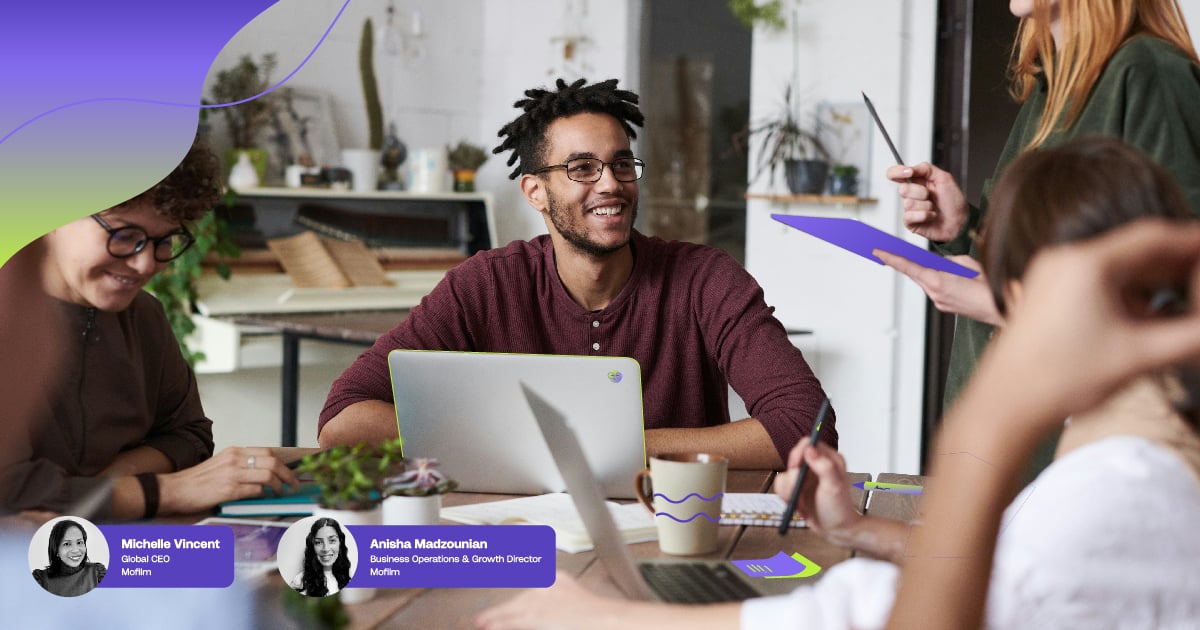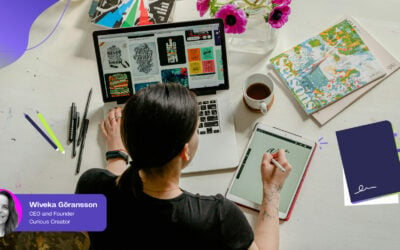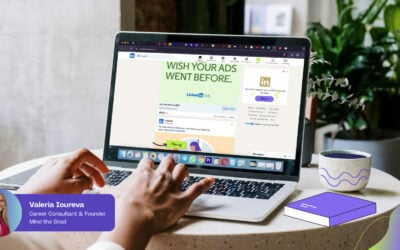
The way we create and consume content is undergoing a massive transformation in 2024. With the rise and change in the social media landscape, streaming platforms, and increased global connectivity, audiences are no longer confined by geographic boundaries. In this interconnected world, global creative communities are coming out on top.
Leading this movement towards globalised ‘content creation networks’ is Mofilm, a company that connects brands with diverse creators to make authentic and culturally relevant content. Mofilm CEO Michelle Vincent and Director – Strategic Operations Anisha Madzounian share their journey and insights with us.
What has changed?
As most people already know, Artificial Intelligence (AI) has already taken over many of the smaller parts of content creation (whether it will take over the rest is a conversation for another day). The one thing that really sets apart AI-generated content from human-created content is … the people themselves.
The audience today craves authentic and culturally relevant content that resonates with their diverse experiences and perspectives. In this environment, content creation is entering a new paradigm.
Platforms such as Instagram, TikTok, LinkedIn, YouTube, Twitch and more have disrupted the scene as they provide creators with direct access to their audiences. Social media platforms play a central role in providing creators with the tools and platforms they need to reach their audiences in a way that wasn’t possible in the past.
These platforms offer personalised experiences and allow users to curate their feeds, fostering authenticity and engagement. In fact, we are seeing more platforms debut with their own unique characteristics—different features, different pros and cons, and even different audience needs and wants.
The creator economy, where individuals can turn their passions into profitable careers by producing content that resonates with their followers, has never been stronger.
The relatively recent boom is characterised by the democratisation of content creation, where anyone with a smartphone and an internet connection can become a creator. This shift has been fueled by a change in consumer behaviour, with audiences seeking out content that aligns with their interests and preferences.
The rise of global creative communities
Today, global creative communities are changing the game in content creation, bringing creators from around the world together to collaborate on projects. The emergence of global creative communities signifies the most collaborative phase of content creation yet, harnessing the power of technology to connect creators from diverse backgrounds and geographical locations.
How do they operate?
For starters, many such creative communities operate primarily through digital platforms and online marketplaces that facilitate collaboration and communication among creators and brands. These platforms provide a centralised hub where creators can showcase their portfolios, connect with potential collaborators, and participate in content creation projects.
A few agencies/companies, like Mofilm, employ a rigorous curation process to onboard creators into their network. This ensures that skilled and experienced professionals are part of the community, maintaining high standards of quality and creativity. Curation also enables communities to foster a sense of belonging and trust among members.
Once onboarded, creators have access to a diverse range of content-creation projects initiated by brands, agencies, and production companies. These projects span various industries and content formats, from video ads and short films to social media campaigns and branded content. Creators can browse project briefs, pitch their ideas, and collaborate with other team members to bring the vision to life.
Additionally, global creative communities leverage remote collaboration tools and cloud-based technologies for easy communication and workflow management. Video conferencing, project management software, and file-sharing platforms enable creators to collaborate effectively despite being geographically dispersed. Real-time editing, commenting, and version control features ensure that the creative process remains fluid and efficient.
They also facilitate collaboration between creators and clients, streamlining the client approval process and ensuring that projects are delivered on time and within budget. Clients have access to project dashboards, review cycles, and communication channels where they can provide feedback, track progress, and communicate their vision effectively.
To top it off, many global creative communities offer expert oversight and guidance throughout the content creation process. Experienced professionals, often with backgrounds in advertising, filmmaking, or digital marketing, provide mentorship, feedback, and creative direction to ensure that projects meet the client’s objectives and quality standards. This mentorship aspect distinguishes global creative communities from traditional freelance platforms and fosters continuous learning and skill development among creators.
Something vital to note is that one of the key advantages of global creative communities is their ability to tap into diverse cultural perspectives and insights. Creators from different regions bring their unique cultural experiences, storytelling traditions, and aesthetic sensibilities to the table, enriching the creative process and ensuring that content resonates with global audiences.
Community managers and project leads play a crucial role in facilitating cross-cultural collaboration and fostering mutual respect and understanding among team members.
Overall, global creative communities represent a shift in content creation, offering creators unprecedented opportunities to collaborate, innovate, and produce impactful content that resonates with audiences worldwide.
How Mofilm does it
Mofilm works with their wide network—or global creative community—to create content that’s rich in diverse perspectives. They handle everything from start to finish, making sure each project is efficient, high-quality, and true to its roots. Mofilm’s platform links brands like Target, DoorDash, and Unilever with over 10,000 filmmakers and photographers from 182 countries.
In 2021, over half of the creators they worked with were women, and more than half were BIPOC (Black, Indigenous, and People of Colour). This commitment to inclusivity and representation is key to Mofilm’s success in today’s content creation scene.
Despite the challenges of the COVID-19 pandemic, Mofilm saw a huge 28% increase in revenue in 2021. Their success can be attributed to their unique approach to content creation as well as a few other vital factors, as Anisha highlights.
“Mofilm was founded about 15 years ago as a crowdsourcing site, and the first of its kind, too. We got our foundation at the onset of digital media—it was when brands were not yet used to creating content for digital platforms. They started to realise that they needed a volume of content to be able to share on these digital platforms, so that’s how MoFilm got a start as a crowdsourcing site, to cater to those needs,” Anisha explained.
“We did a lot of broadcast campaigns during this period as well. It was just a different landscape for content creation. We would put briefs out and then any creator from around the world could respond to that brief—they could pitch on it. With that, our community grew quickly, too.”
“I remember … meeting filmmakers who were like, ‘I got my start on MoFilm. You guys gave me the break that I needed to be able to go and direct or produce even bigger campaigns afterwards and later in my profession’ … There was a ripple effect. Suddenly, people started associating Mofilm with film school.”
Why does it work so well for Mofilm?
With such a vast network of incredibly diverse people working together, many would expect concerns and roadblocks to be common. For Michelle, it couldn’t be clearer that diversity is, in fact, the most crucial aspect—Mofilm is “inclusive by design”.
“… Look at the typical creator talent that gets hired for some of the largest global multi-divisional brands and the different types of content they make, whether it’s for social or on their website. The typical profile is going to be a well-connected, perhaps not-so-diverse creator who has had a lot of advantages throughout their career. Yet what we found is that when you simply reach into communities to build content for that community, by that community that has shared experiences, not only is the resulting content more authentic … but it also happens to be higher performing,” Michelle explained.
She continued: “That’s only possible when you look outside of the realms of those same creators that are always getting hired and just giving that one chance to … that next big-break creator who might not have otherwise had that chance to get exposed to that brand in any other process.
“If we’re going to put a bench of five of the top directors that we think are just perfect for a national television campaign, we always make sure that at least one person on that bench is a woman, at least one person on that bench is a person of colour, and so on.”
Mofilm realised that upon doing this, they get hired at a much higher rate than industry benchmarks.
“The resulting outcome, when you look at that careful matching, is always higher performing and more authentic. Those brands come back for more, so that’s really a part of our value system and a part of our DNA that has made us so proud to do what we have done,” Michelle elaborated.
“We always consider ourselves successful when those creators whom we’ve made those matchmaking opportunities with are far too famous and far too busy to take our phone calls anymore. We know we’ve done our job.”
How do ‘global’ and ‘local’ content creation compare?
Traditionally, ‘local’ content creation often involves in-house teams or local agencies working within a specific geographic region or market. On the flip side, global creative communities leverage technology and collaboration to bring together individuals from around the world. While these approaches offer certain advantages, they also have limitations. Let’s compare the two.
‘Local’ content creation
Positives
- Local content creators possess an innate understanding of the cultural nuances and preferences of their target audience, allowing them to tailor content effectively.
- In-house teams or local agencies have direct access to stakeholders and decision-makers, facilitating clear communication and alignment on project objectives.
- Proximity in the geographical region means faster response times and streamlined communication, leading to quicker content production and delivery.
Negatives
- Local teams may lack diversity in perspectives and ideas, resulting in content that may not appeal to broader audiences or resonate with global trends.
- Limited access to talent and resources within a specific geographic region can constrain creativity and innovation.
- Local content may be limited in reach and scalability, hindering expansion into new markets or global audiences.
Global creative communities
Positives
- These communities foster diversity in thinking, creativity, and cultural insights, leading to richer and more innovative content.
- By tapping into a global talent pool, organisations can access a wide range of skills and expertise, enhancing the quality and depth of content.
- They offer scalability and flexibility, allowing organisations to adapt to changing market dynamics and reach new audiences globally.
Negatives
- Remote collaboration can present communication challenges due to differences in time zones, languages, and cultural norms, potentially leading to misunderstandings or delays.
- Coordinating diverse teams across different locations requires effective project management and coordination, which can be challenging.
- Offence/misunderstanding can arise if creators are reluctant to learn about differences and sensitivities across cultures.
Given all this, will this form of technology-enabled global collaboration shape the future of content creation? Well, it already has! Budding content creators will soon need to adapt to global creative communities if they want to create exciting, new and highly-sought-after content.
How to navigate this new landscape
If you’re an aspiring content creator, success in this new landscape requires embracing collaboration, seriously levelling up your tech know-how, and honing your craft. A lot is going on and making this decision comes with a hefty tag.
Platforms across the web offer opportunities for monetisation and community building; and as the creator economy continues to evolve, we can expect further innovation and opportunities. Emerging technologies like VR and AR will provide immersive experiences, while niche communities will thrive on specialised platforms.
As part of a global creative community, you will have to consider several things. Are you up for remote working? Do you prefer having a fixed group of coworkers for the remainder of your time at your job? These are just a few of the questions you should be asking yourself.
“It’s really important to evaluate what is most important to you, because there are so many other factors that we have to consider in this decision-making, like whether you want flexibility in your schedule, whether you want to expand your skill sets as a business owner, whether you like networking …” Anisha explained. “These are all things that I think are important to consider because the responses to these questions are going to help you evaluate where you probably will fit in best.”
Another helpful tip you’ll definitely need is to network as much as possible!
As Michelle put it: “There is no limit and you should eat up as much as you can … Not everybody can go to a highly-networked Ivy League college, but you can actually recreate that network and those people that can unlock doors for you on your own.”
Michelle recommends reaching out and asking for a coffee meeting or a 30-minute Zoom. Be very forthcoming about why you’re looking for this connection and highlight that there’s a value exchange you can provide (even in a limited capacity early in your career).
“It’s human nature to want to connect with other people. You never know when that reach out can unlock those new doors for you and unlock that role that you never thought you’d be able to get because you expose people to who you are and the value that you have to offer. I would encourage people to just be aggressive about it and look at it in every aspect, inside your organisation, outside your organisation. LinkedIn is going to be your best friend and you never know who you’re going to meet from there,” she added.
Plus, if you’re looking to enter the field and want to make connections, Anisha has a great suggestion: “We (Mofilm) absolutely do encourage creators to get in touch with us and introduce themselves to us, too. We’re always looking for new creators and new talent to add to the community.”
To conclude, global creative communities represent the future of content creation. As creators and brands embrace this new model, we can anticipate continued growth and transformation in how we engage with and consume content in the future.
Want your career to have the best start in 2024? Book a call with us, let’s talk about it. You can also subscribe to our newsletter for the latest career information, tips, and updates. (They’re both completely free!)



